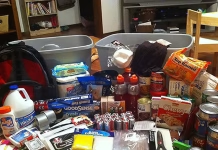Garages are often the go-to spot for stashing extra stuff—whether it’s seasonal gear, tools, or overflow from the house. But while they’re convenient, garages aren’t the best place for everything. Storing the wrong items can lead to damage, pest infestations, or even health hazards, and it might cause issues if you’re trying to sell your home down the line. Drawing from expert advice, here’s a rundown of six things you should never store in your garage, along with smarter storage solutions to keep your belongings safe.
1. Cardboard Boxes, Books, Papers, and Magazines: A Mold and Pest Magnet
Cardboard boxes might seem like a handy storage solution, but they’re a risky choice for the garage. According to Bill Golden, a real estate agent and associate broker at RE/MAX Around Atlanta, cardboard absorbs moisture, which can lead to mold growth—a health hazard and a red flag for home inspectors. Mold spreads quickly in damp environments, and garages are often prone to humidity, especially in climates with temperature swings.
Books, papers, and magazines face similar risks. Beyond mold, these items attract pests like silverfish, which feed on the glue in old book bindings, as noted by professional organizer Marlynn Block. Once pests get a foothold, they can spread to other areas of your home, creating a bigger problem.
Better Solution: Swap cardboard for hard-sided, airtight plastic bins to protect your items from moisture and pests. Store books and papers indoors in a climate-controlled space, like a closet or bookshelf, to preserve them long-term.
2. Pet Food and Birdseed: An Invitation for Rodents

You might think the garage is a convenient spot to store bulk pet food or birdseed, but experts warn against it. Glen Ramsey, senior technical services manager at Orkin, explains that these items should be kept in climate-controlled areas indoors to prevent pest infestations. Rodents and insects are relentless—once they find a food source in your garage, they’ll likely make their way into your home. Block adds that protein-rich dog food is a favorite for mice and even moths, which can lay eggs in the packaging seams.
Better Solution: Store pet food and birdseed inside your home in airtight containers. If you spot moth eggs or larvae, Block suggests freezing the food to kill the pests without tossing it out—just make sure to transfer it to a sealed container afterward.
3. Firewood: A Haven for Termites and Carpenter Ants
Storing firewood in the garage might seem practical, especially during cold months, but it’s a gamble. Ramsey warns that firewood can be a food source for termites and nesting material for carpenter ants. These pests can hitch a ride on the wood, whether you chopped it yourself or bought it, as Block points out. Once inside, they can cause structural damage to your home, which could be costly to repair and a dealbreaker for potential buyers.
Better Solution: Keep firewood outdoors, at least 20 feet from your home, and off the ground to minimize pest risks. Use a wood rack or tarp to protect it from the elements while ensuring proper ventilation to prevent moisture buildup.
4. Out-of-Season Clothes and Fabrics: A Feast for Moths and Mice
It’s tempting to store off-season clothing, sleeping bags, or beach towels in the garage, but these items are prime targets for pests. Laura Ascher, a home expert and DIY influencer, notes that moths and mice are drawn to fabrics, especially in colder months when they’re seeking warmth. Holes in your favorite sweater or chewed-up camping gear can ruin your next outing.
Better Solution: Store fabrics in airtight plastic bins or vacuum-sealed bags and keep them indoors, preferably in a closet or under-bed storage. This keeps them safe from pests and humidity while freeing up garage space.
5. Paint and Home Supplies: Ruined by Temperature Swings

Leftover paint, caulk, or other home supplies might seem like a natural fit for the garage, but temperature fluctuations can render them useless. Ascher explains that paint can freeze, altering its consistency and making it ineffective for touch-ups. Even if it doesn’t freeze, extreme heat can cause it to separate, leaving you with a gloppy mess. This applies to other supplies like refinishing solvents or stains, which can spoil in uncontrolled environments.
Better Solution: Store paint and similar supplies in a cool, dry spot inside your home, like a utility closet or basement shelf. Label paint cans with the date opened and the room they were used in for easy reference, as suggested by professional organizer Diane N. Quintana.
6. Electronics and Photos: Vulnerable to Heat and Humidity
Old electronics—like DVD players, computers, or TVs—and printed photos or documents don’t fare well in the garage. Ascher highlights that winter dampness can cause photos, books, and papers to warp or deteriorate, while extreme heat or cold can permanently damage electronics. These items are often irreplaceable or expensive to repair, making the garage a risky storage spot.
Better Solution: Keep electronics and photos indoors in a temperature-controlled environment. Use a designated drawer or box for documents and photos, and consider donating or recycling electronics you no longer need to free up space.
Why It Matters: More Than Just Clutter
Storing these items in your garage doesn’t just risk damage—it can also impact your home’s value. Golden points out that mold, pest infestations, or visible damage can raise red flags during home inspections, potentially derailing a sale or leading to costly repairs. Even if you’re not planning to sell, these issues can create health hazards, like mold-related respiratory problems, or attract pests that spread to your living spaces.
Final Thoughts: Store Smarter, Not Harder
Your garage can still be a functional storage space, but it’s not a catch-all. Stick to items that can withstand temperature swings and humidity, like tools or seasonal gear in sealed bins, and relocate anything vulnerable to damage or pests indoors. By being mindful of what you store and where, you’ll protect your belongings, maintain your home’s value, and avoid headaches down the road. Ready to declutter your garage? Start by auditing your storage and moving these risky items to safer spots today.
Have you found pests or damage in your garage from improper storage? Share your story in the comments below!








